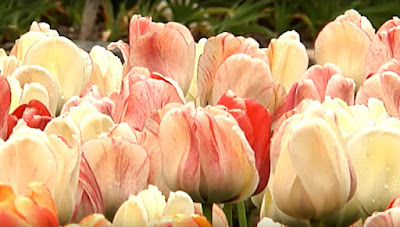Tulip Care
All about tulips. Includes info on tulip care, tulipa sylvestris, parrot tulip, tulip poplar tree, storing tulip bulbs, African tulip, wedding tulips, types of tulips, and more.
Friday, December 15, 2017
Tuesday, September 12, 2017
Tulip Care Guide - How to Take Care of a Tulip Plant
Tulip Care Guide
 |
| Tulip Care Guide |
Tulips are beautiful flowers that can make a wonderful addition to any garden—as long as you know the rules of proper tulip care. That being said, the amount of care involved in gardening tulips pales in comparison to the end result (not to mention that tulips are known for being easy flowers to grow!). We are going to walk you through the task of planting tulip bulbs and describe the general care involved in maintaining your tulips after they have sprouted.
How to Plant, Grow, and Care for Tulip Flowers
 |
| Easy Tulip Care |
The first item on our tulip care guide is the planting process. Most inexperienced gardeners aren’t shy about getting a little dirt under their nails, but the idea of doing something wrong in such a critical process is a little overwhelming. –That’s why tulips make an excellent project for a first time gardener or one with only a little experience. It is a relief to many to learn that tulips aren’t really picky on the type of soil they are planted in. If you are unsure about the quality of your soil, you can buy a little compost to add to the top of the bed after planting. So, the big question is: where to plant them? Tulips do best when planted in groups of about fifteen flowers or so. It’s best to avoid planting them in a straight line. Tulips are pretty hardy little flowers and can thrive in anything from partial shade to full sunlight.
Planting, Growing and Caring for Tulips
 |
| Tulip Care |
I should mention that tulips should be planted in the autumn season. In order for them to bloom in the next spring, they need to be planted in mid to late autumn so that they have a little bit of warmth to spread their roots before winter hits. Once you have your spot picked out and your tulip bulbs have been purchased, it’s time to get your gloves and spade and prepare the bed for the bulbs. You want to dig a shallow hole into the dirt so that the bottom of each bulb is about four or five inches below the surface of the grass. Try to place the pointed end facing upward if you can. This isn’t altogether imperative because tulips are good about finding the direction of the sun, but a little help never hurts. Space the bulbs about six inches apart. Replace the soil you removed from the bed, making sure that it is neither too firm nor too loosely packed into the bed. If you like, spread about half an inch of compost on top of the bed, but no more than one inch or you will have to wipe it away just before spring so your tulips can sprout without difficulty.
How to Care for Tulips
 |
| How to Care for Tulips |
The tulip bed should be watered just after planting. They should also be watered just before blooming in the spring and soon after they have bloomed. Anytime the surface of the soil begins to crack in the spring, the bed should be watered. If your area has a long dry period during the winter without any rain or snow, you may want to give it a light watering. It is important that you do not water the tulip beds during the hot summer months. Tulips originate from areas that have very hot and dry summers and cool, wet springs, so don’t worry about a watering in the summertime. Once the tulips have bloomed and the blossoms have died, you can cut back the stems but be sure to leave the leafy parts intact. This is a great way to ensure that the bulb will retain nutrients and reproduce the bloom next spring time.
As you can see, the overall process of tulip care really isn’t that difficult, even for a novice. In fact, the most difficult part is likely to be deciding which type and colors of this pretty flower you want to plant!
Subscribe to:
Posts (Atom)